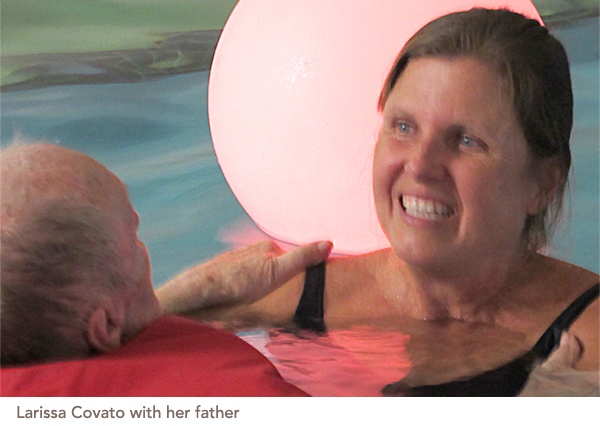 The benefits of swimming as a therapeutic leisure activity are many, ranging from the physical to the emotional. So take these benefits and add in a heavy mix of sensory stimulation, and it should come as no surprise that five residents of Deerwood Creek Care Community had a great time on their visit to Holland Bloorview’s Snoezelen Pool.
The benefits of swimming as a therapeutic leisure activity are many, ranging from the physical to the emotional. So take these benefits and add in a heavy mix of sensory stimulation, and it should come as no surprise that five residents of Deerwood Creek Care Community had a great time on their visit to Holland Bloorview’s Snoezelen Pool.
“The Snoezelen pool engages individuals through the combination of lighting, music, and a warmer temperature to promote relaxation and decrease restlessness,” says recreation therapist Nyema Ahmed. She has been using these techniques with residents at Deerwood Creek for close to a year now, and this was the first time that she and other team members organized the outing to Holland Bloorview Kids Rehabilitation Hospital in Toronto.
Snoezelen sensory stimulation therapy was first developed in Holland during the 1970s. It is used in many of Sienna Senior Living’s care communities to help residents with dementia and Parkinson’s disease.
Snoezelen rooms and their associated tactile and stimulus equipment are in use throughout the world as a therapy for both children and adults. It works by using a variety of multisensory soothing aides, usually in a controlled environment, to stimulate senses through sound, scent, light, and colour.
“Some residents required a bit of encouragement in order to warm up to the experience. However, once they were in the pool, it was difficult to get them back out at the end of the session,” said Nyema.
Larissa Covato’s father is one of the residents who participated in the swim. "The Snoezelen Pool provided my dad with a wonderful opportunity to engage in an activity he had previously enjoyed,” she said. “As a former swimming enthusiast, he took to the therapeutic water environment right away. We both had an amazing time there together."
The residents are all individuals that Nyema regularly meets with on her recreation therapy rounds throughout the week. She typically adapts each session to the needs of each resident for one-on-one programming with a mobile sensory cart. They were all assessed beforehand to ensure they would have their leisure and recreation needs met by attending the pool outing.
“The stimuli in the pool encouraged residents to interact with their environment either actively through movement, or by simply enjoying the atmosphere. We immediately noticed an increase in speech with residents who don’t normally speak, and the relaxation of residents who normally have a stiff posture. We even had one of the resident’s state, ‘I got it from here,’ after getting into the water.”
CONTACT US 0800 920 2222

.jpg)
